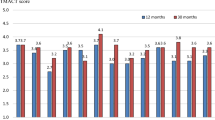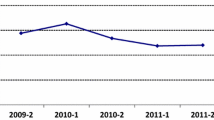Abstract
Introduction
Assertive outreach methods of service delivery hold promise, but have been evaluated mostly in the context of short-lived experiments of limited sustainability and a focus on service use outcomes. The aim of the current investigation was to conduct an observational, “real life”, pre-post comparison of the introduction of assertive outreach in a geographically defined area using clinical rather than service use outcome criteria.
Method
Assertive outreach was implemented in 2002 in a catchment area of 250,000, where cumulative routine outcome measurements had been in place since 1998. Clinical outcome, defined as making a transition to meeting the recently introduced remission criterion, was compared for two non-overlapping cohorts of patients treated in the period 1998–2001 and in the period 2002–2005.
Results
The proportion of patients that made the transition to remission increased from 19% in the period before the introduction of assertive outreach, to 31% in the period after (OR = 2.21, 95% CI 1.03–4.78).
Conclusion
Assertive outreach in real life routine clinical practice brings about detectable changes in clinical outcome. ACT may bring improvement to the lives of patients living in countries characterised by fragmented and hospital-based mental health services.
Similar content being viewed by others
References
Burns BJ, Santos AB (1995) Assertive community treatment: an update of randomized trials. Psychiatr Serv 46:669–675
Crawford MJ, de Jonge E, Freeman GK, Weaver T (2004) Providing continuity of care for people with severe mental illness—a narrative review. Soc Psychiatry Psychiatr Epidemiol 39:265–272
Marshall M, Lockwood A (2000) Assertive community treatment for people with severe mental disorders. Cochrane Database Syst Rev:CD001089
Van Ewijk W, et al. (2005) Richtlijn Schizofrenie (Schizophrenia Guideline). In: Smeets RMW (ed) Landelijke stuurgroep Richtlijnen Ontwikkeling in de GGZ. pp 1–243
Catty J, Burns T, Knapp M, Watt H, Wright C, Henderson J, Healey A (2002) Home treatment for mental health problems: a systematic review. Psychol Med 32:383–401
Kroon H, Henselmans H (2000) Varianten van casemanagement en hun resultaten. In: Pieters G, van der Gaag M (eds) Rehabilitatie strategieen bij schizofrenie en langdurig zorgafhankelijke patienten. Bohn Stafleu Van Loghum, Houten, pp 41–57
Phillips SD, Burns BJ, Edgar ER, Mueser KT, Linkins KW, Rosenheck RA, Drake RE, McDonel Herr EC (2001) Moving assertive community treatment into standard practice. Psychiatr Serv 52:771–779
Burns T, Fioritti A, Holloway F, Malm U, Rossler W (2001) Case management and assertive community treatment in Europe. Psychiatr Serv 52:631–636
Fiander M, Burns T, McHugo GJ, Drake RE (2003) Assertive community treatment across the Atlantic: comparison of model fidelity in the UK and USA. Br J Psychiatry 182:248–254
Killaspy H, Bebbington P, Blizard R, Johnson S, Nolan F, Pilling S, King M (2006) The REACT study: randomised evaluation of assertive community treatment in north London. Bmj 332:815–820
Burns T, Catty J, Wright C (2006) De-constructing home-based care for mental illness: can one identify the effective ingredients? Acta Psychiatr Scand 114(Suppl):33–35
Wright C, Catty J, Watt H, Burns T (2004) A systematic review of home treatment services–classification and sustainability. Soc Psychiatry Psychiatr Epidemiol 39:789–796
Burns T (1999) Methological problems of schizophrenia trials in community settings. In: Guimon J, Sartorius N (eds) Manage or perish? The challenges of managed mental health care in Europe. Kluwer Academic/Plenum Publishers, New York, pp 267–276
Hendryx MS, Doebbeling BN, Kearns DL (1994) Mental health treatment in primary care: physician treatment choices and psychiatric admission rates. Fam Pract Res J 14:127–137
Ruggeri M, Lasalvia A, Bisoffi G, Thornicroft G, Vazquez-Barquero JL, Becker T, Knapp M, Knudsen HC, Schene A, Tansella M (2003) Satisfaction with mental health services among people with schizophrenia in five European sites: results from the EPSILON Study. Schizophr Bull 29:229–245
Andreasen NC, Carpenter WT Jr, Kane JM, Lasser RA, Marder SR, Weinberger DR (2005) Remission in schizophrenia: proposed criteria and rationale for consensus. Am J Psychiatry 162:441–449
van Os J, Burns T, Cavallaro R, Leucht S, Peuskens J, Helldin L, Bernardo M, Arango C, Fleischhacker W, Lachaux B, Kane JM (2006) Standardized remission criteria in schizophrenia. Acta Psychiatr Scand 113:91–95
van Os J, Drukker M, a Campo J, Meijer J, Bak M, Delespaul P (2006) Validation of remission criteria for schizophrenia. Am J Psych 163(11):2000–2002
van Veldhuizen JR (2005) F-ACT: de Funtie ACT, een Nederlandse variant (Function ACT, a Dutch variant). In: Mulder CL, Kroon H (eds) Assertive Community Treatment Wetenschappelijke uitgeverij. Cure & Care Publishers, Nijmegen, pp 175–187
van Veldhuizen JR, Baehler M, Teer T (2006) FACT: de Functie ACT. MGV 61:525-534
van Os J, Delespaul P, Radstake S, Hilwig M, Bak M, Driessen G (2001) Kernparameters ter evaluatie van een zorgpromma van psychotische patiënten. MGv 10
American Psychiatric Association A (1994) DSM-IV: diagnostic and statistical manual of mental disorders. APA, Washinton DC
Slade M (1996) Assessing the needs of the severely mentally ill: cultural and professional differences. Int J Soc Psychiatry 42:1–9
Slade M, Phelan M, Thornicroft G, Parkman S (1996) The Camberwell Assessment of Need (CAN): comparison of assessments by staff and patients of the needs of the severely mentally ill. Soc Psychiatry Psychiatr Epidemiol 31:109–113
Lukoff D, Neuchterlein K, Ventura J (1986) Manual for the expanded Brief Psychiatric Rating Scale. Schizophr Bull 12:594-602
Ventura J, Green MF, Shaner A, Liberman RP (1993) Training and Quality Assurance with the Brief Psychiatric Rating Scale: ‘the drift Busters’. Int J Methods Psychiatr Res 3:221–244
Delespaul P, Bak M, Van Os J (2002) Handleiding Maastrichtse Psychoseprotocol. Maastricht University, Maastricht
Driessen G, Gunther N, Bak M, van Sambeek M, van Os J (1998) Characteristics of early- and late-diagnosed schizophrenia: implications for first-episode studies. Schizophr Res 33:27–34
van Os J, Driessen G, Gunther N, Delespaul P (2000) Neighbourhood variation in incidence of schizophrenia. Evidence for person-environment interaction. Br J Psychiatry 176:243–248
Statacorp (2005) Statistical Software: release 9. Stata Corporation, College Station, TX
van Os J, Neeleman J (1994) Caring for mentally ill people. Bmj 309:1218–1221
Author information
Authors and Affiliations
Corresponding author
Rights and permissions
About this article
Cite this article
Bak, M., van Os, J., Delespaul, P. et al. An observational, “real life” trial of the introduction of assertive community treatment in a geographically defined area using clinical rather than service use outcome criteria. Soc Psychiat Epidemiol 42, 125–130 (2007). https://doi.org/10.1007/s00127-006-0147-y
Published:
Issue Date:
DOI: https://doi.org/10.1007/s00127-006-0147-y




